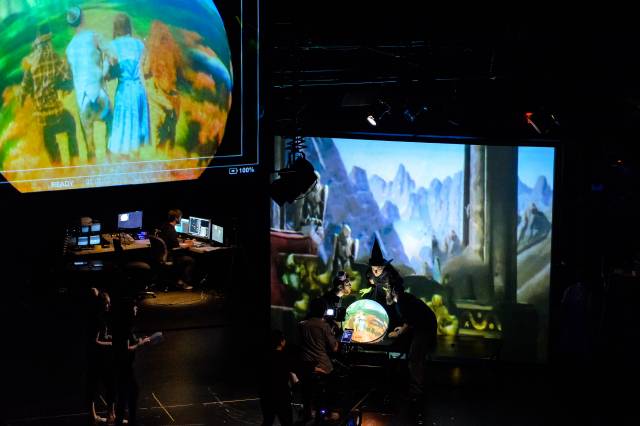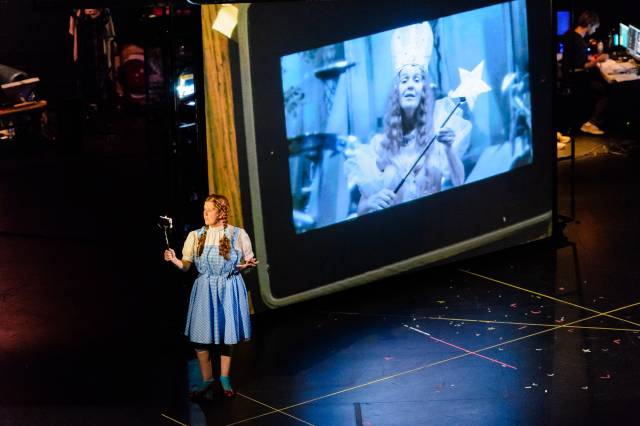

In the stunning Elements of Oz (The Builders Association production at 3LD through December 18), audience members get to be part of the creation of the classic 1939 film of The Wizard of Oz. Through the use of inventive technology - and our smartphones - we are invited to discover and contribute in the magic of filmmaking. As we see actors recreate scenes from the shooting of the film, we are asked to become active viewers of something that combines the historical importance of a Ken Burns documentary, with the delightful giddiness of VH1’s Pop Up Video. But to suggest the show is only about Hollywood trivia would be a disservice, since it does what all great art about great art should do: it invites us to see what we thought was familiar with brand new eyes. I spoke to cast member and co-writer Moe Angelos about the work that goes into the show, and her love of all things Oz.
The show made me feel like a kid. Can you talk a little bit about the spark that started this idea to do the show?
Marianne Weems, the artistic director of The Builders Association and director of the piece, James Gibbs who is the co-writer with me, and me were talking about the project by thinking about Depression era entertainment and the various escapisms that developed during the era. Not only fantastical musicals like The Wizard of Oz, but epics like Gone with the Wind, these grand scale productions, and also detective stories. We landed on the most delicious escape of all which to me is The Wizard of Oz, we were coming out of the Recession which we still can feel - except for the rich people who get richer and richer - so we landed on Oz as something to look at as a piece of art, but also the many ways in which people feel attached to the movie. It lodges in us, it does something to the child part of us even if we know it’s all fake. It’s a beautiful film, so it has many entry points.
The show touches on so many things about the film, and also its effects on pop culture. We see Salman Rushdie talking about it, we hear about its legacy for queer people, we see Ayn Rand as the Wicked Witch of the West. Considering there were so many entry points how did you narrow them into a cohesive show?
It was a tremendous challenge to try and edit down the many, many, many influences that people deride from the movie, they think it’s a conspiracy about money policy, they think it’s a story about populism - which is interesting given our electoral situation - that whole storyline about populism we had to leave by the wayside because we didn’t know how to put it in. The movie provokes ideas and attachment, so it was hard to distill the stories we wanted to tell, the contemporary stories the movie reminds us of when we watch it.

The quote in the movie says “pay no attention to that man behind the curtain”, and your show is about paying all the attention to the man behind the curtain. How did you discover magic in the dissecting of magic?
The work of The Builders Association is often about technology in the sense that we live in a world where we have access to these powerful technologies that we carry with us all the time. Our phones do so many things that we want them to do, and things we might not even know about, so there’s still a lot of behind the curtain going on. Our work is often about trying to explore a little bit about what is the interaction between humans and these technologies. For this show we were thinking about our relationship to our phones, and how we use our attention. Now we have second screen watching, we’re watching a movie and Googling information about the actors. People are looking at their screens when they’re walking, they toggle between the screen and good old “IRL” reality. There’s magic in that, because the phone is magic. Marianne’s premise was that the magical world we escape to is our phone, our phones are Oz. In the show the phone laughs like the Munchkins, plays versions of “Somewhere Over the Rainbow”, so we wanted to stage that magic we often take for granted. We also wanted to show the magic from 1939, all the theatrical magic they used in the movie.
Asbestos and speed on poor Judy.
Poor Judy.
Who is your favorite character that you get to play?
Oh my God, Glinda! She’s a delight, I get to wear that crazy dress, and Billie Burke was a stage and film actress who played all these great comedic roles.
There are strange people out there who don’t know the movie. Do these people ever come to the show?
Not a soul. I can tell very early in the show if there are a lot of people who know the movie very, very well. At the beginning when we recreate a scene from the film, done in non-linear order, people who know the movie and hear me saying the line about coming back home, people who know the movie start giggling. We haven’t met people who don’t know the movie, that’s also why we chose it, the story is already embedded in people, they know it well even if they haven’t seen it recently. We’re telling other stories.
Is there a particular viewing of The Wizard of Oz that you remember the most?
I’m a middle aged lady, so the first times I saw the film I was a little girl, they used to broadcast it on television and I remember watching it. In the mid-70s sometime, we got a color television set and I had only seen it in black and white, so I didn’t know Dorothy went into color when she went to Oz, and that blew my mind! I saw it later projected in a movie theater, in an enhanced print, but it was a little too enhanced, I could see the makeup on Margaret Hamilton’s neck, it was a bit too much.
Is there a piece of trivia you learned about the movie, that’s not in the show, but you love telling people about?
The little people who played the Munchkins in the film weren’t professionals, because it was also the year of the World’s Fair in NYC and many little people who were performers were on that gig doing some sort of Lilliput exhibit or something crazy like that, so all the little people in showbusiness were taken by that. So they started a bus in NYC and drove across the country to California picking up little people who would be in the movie. None of them were performers, they were taught how to dance they had to do an elaborate technology to make them sound high pitched like that. I really could go on and on though.
For more on Elements of Oz click here.